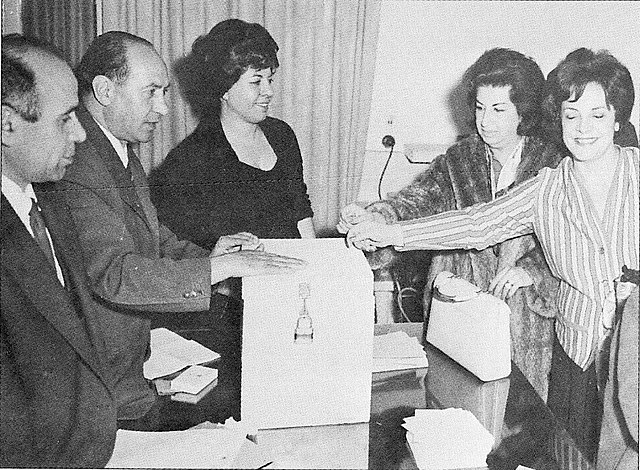1963_Iranian_constitutional_referendum
1963 Iranian referendum
Iranian referendum
A referendum was held in Iran on 26 January 1963 by the decree of Mohammad Reza Shah, with an aim to show popular support for him, asking voters to approve or veto the reforms of the White Revolution.[3]
| ||||||||||||||||||||||
"White Revolution of the Shah and the People":[1]
| ||||||||||||||||||||||
| Results | ||||||||||||||||||||||
|---|---|---|---|---|---|---|---|---|---|---|---|---|---|---|---|---|---|---|---|---|---|---|
| ||||||||||||||||||||||
| 271,179 announced additional votes cast by women were counted separately but not considered in the official results[2] | ||||||||||||||||||||||

Women were not officially allowed to vote, but were set up to vote at their own balloting counters and dedicated boxes, at the suggestion of Ministry of Agriculture Hasan Arsanjani. The results gave Iranian women the right to vote.[4]
Despite the apparent benign nature of the proposals in the referendum, there was significant opposition.[5] Opponents included major landowners, ulema and communists.[3]
Ayatollah Ruhollah Khomeini called for boycotting the referendum as "un-Islamic".[6]
National Front boycotted the referendum, criticizing that the measures did not come from the parliament.[5]
Voters were asked six questions, but had only the option to vote yes or no to the total package.[7]
The ballots for 'Yes' were white, while the negative ones were green.[2]
Similar to the previous referendum, polling places lacked secrecy and there were two separate voting booths: one for the supporters and one for the opponents. "No sane man would enter the opposition booth", according to Mohammad Gholi Majd.[1]
| Position | Organization | Ref |
|---|---|---|
Yes |
Nationalists’ Party | |
| People's Party | ||
| Pan-Iranist Party | ||
Boycott |
National Front | [5] |
| Freedom Movement | [8] |
Following the referendum dissension and riots outbroke in almost all major urban areas, most significantly in Tehran and the city of Qom. The Shah gave orders to immediate suppression of the opposition and National Front, Freedom Movement, Tudeh Party and religious activists were imprisoned.[9] The unrest made Ayatollah Ruhollah Khomeini the regime's principal opponent in the minds of most Iranians.[6]
- Majd, Mohammad Gholi (2000), Resistance to the Shah: Landowners and Ulama in Iran, University Press of Florida, pp. 260–261, ISBN 978-0813017310
- E. A. Bayne (1965), Four Ways of Politics: State and Nation in Italy, Somalia, Israel, Iran: The Dynamics of Political Participation as Exhibited in Four Countries Caught Up in the Process of Modernization, American Universities Field Staff, p. 260
- Lloyd Ridgeon (2005). Religion and Politics in Modern Iran: A Reader. I.B.Tauris. p. 173. ISBN 978-1-84511-073-4.
- Lois Beck; Guity Nashat, eds. (2004). Women in Iran from 1800 to the Islamic Republic. University of Illinois Press. p. 139. ISBN 978-0-252-07189-8.
- Elton L. Daniel (2012). The History of Iran. ABC-CLIO. p. 157. ISBN 978-0313375095.
- Edward Willett (2003). Ayatollah Khomeini. The Rosen Publishing Group. p. 42. ISBN 9780823944651.
- Nohlen, Dieter; Grotz, Florian; Hartmann, Christof (2001). "Iran". Elections in Asia: A Data Handbook. Vol. I. Oxford University Press. p. 72. ISBN 978-0-19-924958-9.
- Hiro, Dilip (2013). Iran Under the Ayatollahs (Routledge Revivals). Routledge. p. 104. ISBN 978-1135043810.
- Marvin Zonis (2015). Political Elite of Iran. Princeton University Press. pp. 75–77. ISBN 9781400868803.